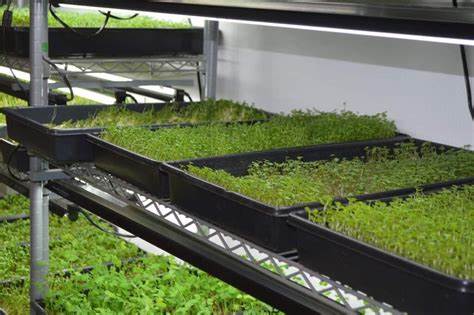
Vertical Farming and the Circular Economy of Agriculture
Introduction
The concept of vertical farming has gained significant attention in recent years due to its potential to revolutionize the agricultural industry. This article explores the relevance and importance of vertical farming in the context of the circular economy.
Historical Background
Evolution of Agriculture Practices
Throughout history, agriculture practices have evolved in response to various factors such as population growth, technological advancements, and changing environmental conditions. From traditional farming methods to industrialized agriculture, the sector has constantly adapted to meet the growing demand for food.
Emergence of Vertical Farming and Circular Economy Concepts
In recent decades, the emergence of vertical farming has provided a sustainable alternative to traditional farming practices. Vertical farming involves cultivating crops in vertically stacked layers, using controlled environments that optimize resource use and minimize environmental impact. This concept aligns with the principles of the circular economy, which aims to create a closed-loop system by minimizing waste and maximizing resource efficiency.
Key Concepts and Definitions
Vertical Farming: Definition, Principles, and Techniques
Vertical farming refers to the practice of growing crops in vertically stacked layers or vertically inclined surfaces. This approach utilizes technologies such as hydroponics, aeroponics, and aquaponics to create controlled environments that provide optimal growing conditions for plants. By utilizing artificial lighting, nutrient-rich solutions, and efficient water management systems, vertical farming maximizes crop yield per unit of land.
Circular Economy of Agriculture: Definition and Principles
The circular economy of agriculture is a concept that aims to minimize waste, reduce resource consumption, and promote sustainable practices within the agricultural sector. It involves the integration of circular economy principles, such as closed-loop nutrient cycles, waste reduction, and utilization, and synergistic agricultural systems, into farming practices.
Benefits of Vertical Farming in the Circular Economy
Vertical farming offers numerous benefits within the circular economy framework.
Reduction in Resource Consumption
Vertical farming significantly reduces resource consumption compared to traditional farming methods. By utilizing vertical space effectively, it requires less land area and water for cultivation. Additionally, energy-efficient LED lighting systems and advanced climate control technologies minimize energy consumption.
Increased Food Production in Urban Areas
Vertical farming allows for food production in urban areas, reducing the need for long-distance transportation and storage. This proximity to consumers reduces the carbon emissions associated with transportation and ensures the availability of fresh produce.

Reduced Transportation and Carbon Emissions
With vertical farms located within or near urban areas, the need for long-distance transportation of produce is minimized. This not only reduces carbon emissions but also ensures that crops are harvested at peak freshness, leading to higher nutritional value and improved taste.
Integration of Circular Economy Principles in Vertical Farming
Vertical farming inherently aligns with circular economy principles, making it a sustainable and efficient agricultural practice.
Closed-Loop Nutrient Cycles
Vertical farming systems often incorporate closed-loop nutrient cycles, where the waste from one crop becomes a nutrient source for another. By recycling nutrients, the need for synthetic fertilizers is reduced, minimizing environmental pollution and resource depletion.
Waste Reduction and Utilization
Vertical farming enables the efficient use of resources, as it eliminates the need for excessive irrigation and reduces water wastage. Moreover, waste products such as plant residues and byproducts can be repurposed as compost or utilized for energy generation, further contributing to the circular economy.
Synergistic Agricultural Systems
Vertical farming can be integrated with other agricultural systems, such as aquaculture or livestock farming. This allows for symbiotic relationships, where waste products from one system become valuable inputs for another. Such synergistic systems enhance resource efficiency and promote sustainable practices.
Case Studies or Examples
Example: AeroFarms – An Innovative Vertical Farming Company Utilizing Circular Economy Principles
AeroFarms is a leading company in the field of vertical farming, known for its innovative technologies and commitment to sustainable agriculture.
Overview of AeroFarms’ Operations and Technologies
AeroFarms utilizes aeroponic systems, where plants are grown without soil, using nutrient-rich misting systems. By optimizing light, water, and nutrient delivery, AeroFarms achieves higher crop yields while using significantly less water compared to traditional farming methods.

How AeroFarms Contributes to the Circular Economy of Agriculture
AeroFarms embraces circular economy principles by implementing closed-loop nutrient cycles. The company recirculates the nutrient-rich misting solution, reducing the need for synthetic fertilizers. Additionally, AeroFarms collaborates with local communities, providing fresh produce and creating job opportunities, thereby contributing to sustainable economic growth.
Example: The Plant – A Chicago-based Vertical Farm and Food Business Incubator
The Plant is a unique vertical farm located in Chicago that goes beyond food production. It serves as a food business incubator, housing multiple sustainable businesses under one roof.
Description of The Plant and Its Circular Economy Practices
The Plant utilizes an aquaponics system, where fish waste provides nutrients for the plants, while the plants filter the water for the fish. This closed-loop system minimizes waste and maximizes resource efficiency. Additionally, The Plant houses various businesses that repurpose waste streams, creating a circular economy ecosystem.
Success Stories of Bu+sinesses Operating within The Plant
Numerous businesses within The Plant exemplify the circular economy principles. For example, a brewery utilizes waste heat from the vertical farm to provide heating for their production process. Additionally, an organic mushroom farm utilizes waste coffee grounds from a neighboring coffee shop as a substrate for mushroom cultivation. These innovative practices demonstrate the potential for circular economy integration within vertical farming.
Current Trends or Developments
Technological Advancements in Vertical Farming Systems
Vertical farming systems are continually evolving and benefiting from technological advancements. Innovations such as advanced LED lighting systems, automated climate control, and robotic harvesting are enhancing resource efficiency and crop productivity. These advancements are making vertical farming more economically viable and scalable.
Integration of IoT and AI in Optimizing Resource Efficiency
The integration of the Internet of Things (IoT) and Artificial Intelligence (AI) technologies in vertical farming enables real-time monitoring and control of environmental parameters. This optimization of resource use, including electricity, water, and nutrients, contributes to the circular economy by minimizing waste.
Research Findings on the Environmental and Economic Benefits of Vertical Farming
Research studies are highlighting the significant environmental and economic benefits of vertical farming. These include reduced water consumption, minimized pesticide use, and increased crop yields. Moreover, vertical farming can create employment opportunities, enhance food security, and contribute to sustainable urban development.
Challenges or Controversies
Energy Consumption and Carbon Footprint of Vertical Farming
Vertical farming requires a significant amount of energy to power lighting systems and maintain optimal growing conditions. This energy consumption contributes to carbon emissions, which can counteract the environmental benefits of vertical farming. The challenge lies in finding renewable energy sources and implementing energy-efficient technologies to minimize the carbon footprint.

Cost and Scalability Issues
The initial setup costs of vertical farming systems can be high, limiting their accessibility to small-scale farmers. Additionally, scaling up vertical farming operations to meet the demand for mass food production presents challenges in terms of cost-effectiveness and efficient management. Overcoming these issues requires innovative financing models and technological advancements that reduce costs and improve scalability.
Debate over the Sustainability and Long-Term Viability of Vertical Farming
While vertical farming offers numerous benefits, there is ongoing debate regarding its sustainability and long-term viability. Critics argue that the energy-intensive nature of vertical farming negates its environmental benefits. Additionally, concerns have been raised about the limited crop diversity and potential dependence on synthetic nutrients. Addressing these concerns requires continuous research, innovation, and the integration of sustainable practices within vertical farming systems.
Future Outlook
Potential for Widespread Adoption of Vertical Farming in Urban Areas
As urbanization continues to increase, the demand for locally grown food will rise. Vertical farming presents a promising solution to meet this demand sustainably. Its ability to produce food in urban areas, reduce transportation requirements, and optimize resource use positions it as a viable solution for future food production.
Integration of Vertical Farming in Smart Cities and Sustainable Urban Planning
The integration of vertical farming in smart cities and sustainable urban planning can further enhance its impact. By incorporating vertical farms into urban infrastructures, cities can achieve self-sufficiency in food production and reduce their environmental footprint. Vertical farming can also contribute to the creation of green spaces and improve the overall well-being of urban dwellers.
Advancements in Vertical Farming Technologies and Increased Efficiency
The continuous advancements in vertical farming technologies will lead to increased efficiency and cost-effectiveness. As research and development efforts progress, the scalability and economic viability of vertical farming will improve, making it a more accessible and sustainable solution for agricultural production.
Conclusion
Vertical farming, within the framework of the circular economy, offers a sustainable and efficient approach to agriculture. It enables resource optimization, minimizes waste, and promotes local food production. Despite challenges and controversies, the potential of vertical farming to transform the agricultural industry and contribute to a sustainable future cannot be overlooked. Its integration in smart cities and ongoing technological advancements will shape the future of food production, ensuring food security and environmental stewardship.




